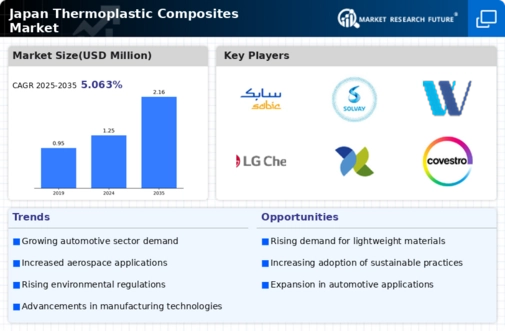The Japan Thermoplastic Composites Market represents a dynamic and competitive landscape characterized by innovation and technological advancements. As demand increases for lightweight, durable materials across various sectors, including automotive, aerospace, and consumer goods, the competition in this market intensifies. Companies are focusing on product development, strategic partnerships, and regional expansion to secure their market presence.
Additionally, factors such as environmental sustainability and demand for improved fuel efficiency are driving companies to innovate and enhance their offerings in thermoplastic composites. Players in this market are also increasingly investing in research and development to cater to evolving customer needs, making the competitive environment both challenging and opportunities-driven.SABIC is a significant player in the Japan Thermoplastic Composites Market, leveraging its strengths in advanced polymer technologies and innovative material solutions.
SABIC's robust production capabilities and commitment to sustainability have positioned it as a preferred supplier in various industries. The company offers a wide range of thermoplastic composite products, aimed at enhancing performance while reducing overall weight. Its strong relationships with local manufacturers and end-users enable SABIC to tailor its solutions according to Japanese market needs. In addition to its focus on product development, SABIC's dedication to quality and customer service further bolsters its competitiveness in the region, ensuring that they meet the growing demands of the market while promoting sustainable practices.
Hexcel Corporation also underscores its significance within the Japan Thermoplastic Composites Market, known for its advanced composites and aerospace-grade materials. The company specializes in high-performance thermoplastic composite solutions that cater to the distinct needs of the aerospace, automotive, and industrial sectors. Hexcel's commitment to innovation is reflected in its capabilities to combine lightweight and strength, leading to enhanced performance in its offerings. The company's strategic initiatives, including collaborations and potential mergers, have enabled it to expand its footprint in the Japan market.
By focusing on automation technology and developing next-generation materials, Hexcel is boosting its presence while ensuring it remains competitive in a rapidly evolving industry landscape.
Furthermore, Hexcel's reputation for quality and its technical expertise in thermoplastic composites enhance its appeal to a diverse set of customers in Japan.























Leave a Comment